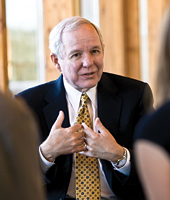It’s Not That Easy
Becoming a Leader in a Complex World

As a leader, a university president interacts with multiple constituencies, from students and faculty to trustees, alumni, government officials, and donors. |
Kermit the Frog once said so eloquently: “It’s not that easy being green.” Sometimes you’d like to be something “nicer,” like “red, or yellow or gold or something much more colorful like that.”
Sometimes you’d like to stand out, says Kermit, “like flashy sparkles in the water/Or stars in the sky.”
Of course, Kermit was singing to the kid with the curly, red hair, the one who would like to have hair like everyone else; or to the girl who was too tall; or the boy too short. With his plaintive, touchingly gentle voice, I’m sure he was also trying to affirm our ethnic and racial differences. He was saying, it’s not that easy being who we are, in a world that wants us to be something else, but in the end “it’s beautiful” being green, “and I think it’s what I want to be.”
I’d like to think Kermit might also be talking about being a leader in our day: “It’s not that easy” always being out on the point; not that easy being misunderstood, misjudged about motives, being characterized too often as foolish or misguided or uninformed. It’s not that easy when everyone knows your job better than you do. For all of the extraordinary privilege of being chosen to be a leader, Kermit is right: “It’s not that easy.”
We’ve been raising the questions of leadership across our campus these days. We gathered in our Day of Common Learning under the guidance of Lincoln scholar and biographer and my friend, Ron White. We tried to ask this question: What would Lincoln say about leading in our time? How do we lead when our culture is so splintered, so divided and divisive, as Lincoln’s was? When you see the opinion polls of a very popularly elected president plummet within a year’s time, you know “it’s not that easy.” When you see CEOs all over the country toppled from their pedestals, often by reason of broken trust or damaging mistakes, but often simply because they had to lead out on an unpopular decision — you know “it’s not that easy.”
I worry that young people watching all of this will want to “blend in with so many other ordinary things,” as Kermit says, rather than stretching themselves to lead out on things that matter.
I have been thinking a lot about Lincoln’s leadership over the last few years. How did Lincoln lead? If there was ever a time when our country was divided, it was Lincoln’s time. Americans had decided that unity on issues that matter was simply impossible: the question of human dignity for all people; the question of equality; the question of justice for all; the question of who had the right to choose the common good. This experiment in democracy hung in the balance; the unity of the nation was at stake. How to lead in such a moment? How was it possible to locate the deeper principles that guided leadership in this moment?
Lincoln’s great Second Inaugural Address may be one of the most important texts in all of American history, and it says a great deal, of course, about Lincoln’s leadership. Listen to the way this great speech ends:
With malice toward none; with charity for all; with firmness in the right, as God gives us to see the right, let us strive on to finish the work we are in; to bind up the nation’s wounds; to care for him who shall have borne the battle, and for his widow, and his orphan — to do all which may achieve and cherish a just and lasting peace, among ourselves, and with all nations.
As the great and bloody war was coming to its close, ultimately these were the principles of leadership for Lincoln. “With malice toward none,” he begins this closing. Of course, this was a time of “victory” for Lincoln and the forces of the North. It could be a time of malice and resentment and vengeance. No, Lincoln as a leader was driven by “charity for all.” Imagine that as a principle of leadership for our time: We must keep our anger in check. We must actually love each other. We must commit ourselves to reconciliation and the common good.
But that’s not all: We must lead “with firmness in the right,” Lincoln says. We must be guided by clear principles. We must be guided by a story of human flourishing. This is where Lincoln and all leaders must dig down to decide what is right and good and true. It is about people, to be sure, but it is also about what is right. We must be guided by a story of what is true and good and beautiful. “It’s not that easy” leading in this way in our postmodern moment when all such stories are called into question.
But even this is not enough. Leading is about “charity for all,” and it is about “firmness in the right.” But watch what Lincoln does next: It is about leading in the light of what is right “as God gives us to see the right.” This is the profound posture of humility at the very heart of Lincoln’s leadership. This is the final test of good leadership, one that is so often missing in all of us who lead.
Kermit wants to “be big like an ocean, or important/Like a mountain, or tall like a tree,” but ultimately his humility wins out. Kermit has it right. And Lincoln has it right. These are the principles of leadership for our time, even when “it’s not that easy.”
—By Philip W. Eaton
—Photos By Mike Siegel
Return to top
Back to From the President Home
|